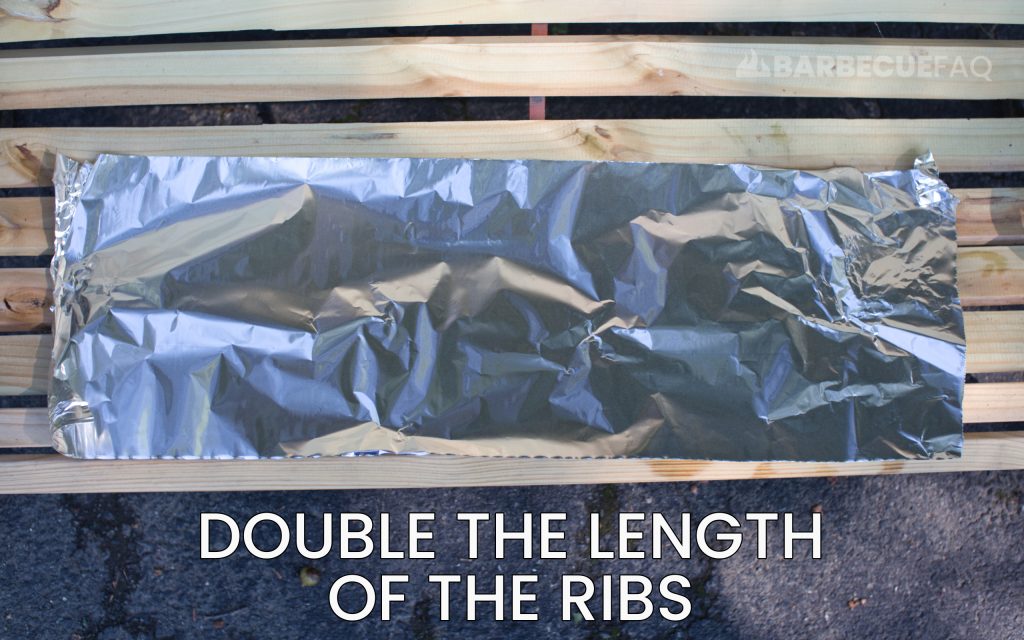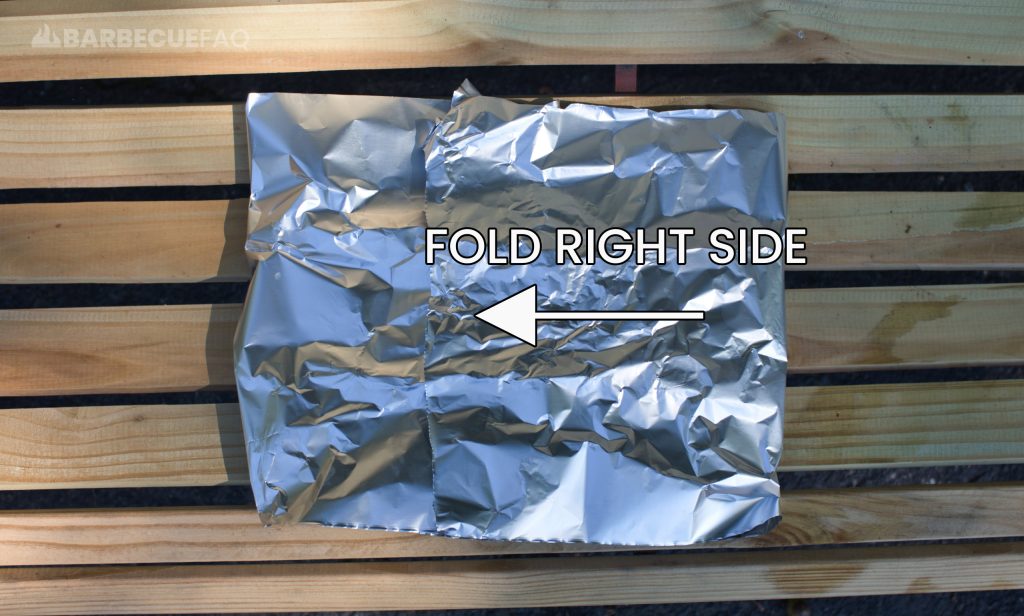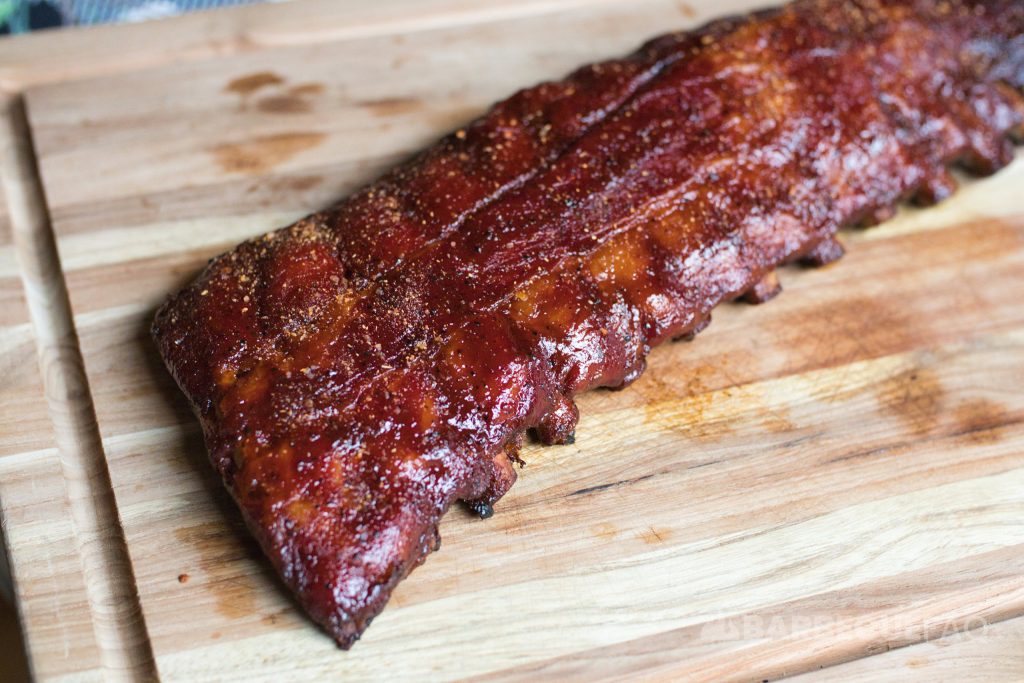1. Start by Laying out a Sheet of Aluminum Foil that’s Double the Length of the Ribs
This is a standard sheet of aluminum foil – heavy duty stuff works best though.

2. Add Your Ingredients to the Wrap (If Any)
Personally, all I use is a spritz of warm water on the foil.
Regardless of if you wrap with a liquid or not, moisture will accumulate in the wrap and beat the stall.
If you like to “liquid wrap” you might use:
- Pats of butter or some margarine
- Sugars like maple syrup, honey, agave nectar, etc.
- Cider vinegar or white vinegar
- BBQ Sauce diluted with water and vinegar
- Worcestershire sauce
- Fruit juice, like apple
- Beer
- Some of your rub
The list goes on – usually it’s some form of liquid, a fat, and a sugar.
3. Put the Ribs Meat Side Down in the Middle of the Foil
If you added wrap ingredients, put the ribs on top.

4. Fold From the Left – Horizontally – and Cover Half the Rack

5. Then Repeat from the Right
If you used enough foil, you should be able to overlap in the middle.

6. Fold From the Bottom – Vertically- and Crinkle the Foil in the Middle

7. Repeat from the Top
Typically if I liquid wrap, I’ll add the liquid at this stage before crinkling.

Once wrapped, return to your smoker meat side down.
This way the meat continues to tenderize in the liquids.
Why I Hate Wrapping with Sugars, Butter, and More
Almost every website or YouTube video likes to treat you like a Barbecue Competitor and teaches you how to wrap ribs like one.
In my opinion, it’s quite literally to the point where you can barely taste pork. While I’m not saying competition style ribs are bad, you just borderline need to take a nap after you eat them.

In a BBQ contest a judge takes one bite of a rib – meaning that singular bite needs to pack a punch. Where-as in backyard barbecue, your goal is to make food that people want to eat more of.
Personally, all I do when I wrap ribs is spritz the foil with warm water and then put the ribs meat side down.
The moisture build up and rendered fat will collect in the bottom of the wrap and serve the same purpose – which is to tenderize the meat.
Once they reach tenderness, you can sauce the ribs and allow them to rest.





5 comments
Tyler Torres
Is it not a better idea to wrap them first so they get extra juicy and tender and then finish them in direct heat to get a really nice crust? like reverse searing a steak? If you build the bark first and then wrap them does it not make them soggy or ruin the crust? Genuinely curious my man! Good idea on the heavy duty tin foil that’s the reason I looked at this to begin with.
Dylan Clay
Hey Tyler,
Good question.
So, in my opinion, what you’re referring to with regards to “bark” on a steak and the “bark” of smoked meat are categorically different.
Bark on smoked meat is a combination of smoke/maillard reactions forming a pellicle (a skin) on the surface of the meat. The main ingredients that have the biggest impact here are sugar and pepper – people will use 16-mesh black pepper specifically for this reason, to create a crispy/crunchy bark.
Most if not all rubs that are used for pork are sugar-heavy because sugar and pork pair well together (it’s the same reason people use apple juice). With that said, sugar has a scorch point and if left in direct/radiant heat for too long, you’ll burn the sugar and the result is an exterior that tastes bitter. This is often one of the main reasons people go indirect or low and slow (225-275F) is because it’s under the scorch point of the sugar.
Where-as if you experiment long enough (like me), if you go high at around 300-350F and your rub is sugar-heavy, you’ll burn the bark.
–
Now if you were to do a traditional sear, you still risk burning the sugars (sear first, then smoke). Wrapping will cause the bark to turn soggy, no matter what. This is simply a consequence of trapping steam as steam turns the exterior bark soggy/soft. This steam is also the point of wrapping, it increases the humidity thus preventing the “Sweating” of the meat.
–
Also worth noting – “juiciness” and “tenderness” with regards to steak and smoked meat are two entirely different things. Steak gets juiciness via free moisture content; This is why you go to medium-rare because you’re optimizing the amount of free-moisture. Where-as if you go higher, the more free moisture is lost.
Smoked meat, like ribs, get “juiciness” and “tenderness” via the conversion of collagen (connective tissue) into gelatin. Gelatin is hydroscopic and will absorb up to ten times its weight in liquid.
Again, these are two entirely different things.
King
Good information THANKS
David W. Alford
Outstanding and very helpful and simple directions for a rookie pellet smoker!
Dylan Clay
Happy to help David!
-Dylan